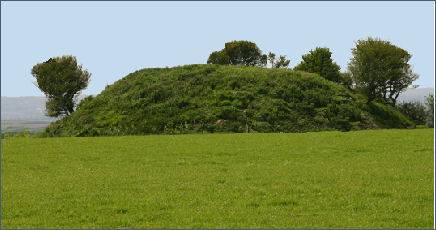Veryan
OS grid reference SW 9139
 The picturesque and historic village of Veryan, a popular tourist destination on the Roseland Peninsula is mentioned in the Domesday Book of 1086, as the manor of Elerchi.
The picturesque and historic village of Veryan, a popular tourist destination on the Roseland Peninsula is mentioned in the Domesday Book of 1086, as the manor of Elerchi.
The village's present name is a corruption of St Symphorian, who in 1525 had become St Severian.
The village features five thatched roundhouse cottages at its entrance, each topped by a cross (pictured left), the unique buildings date back to the nineteenth century. They were originally built by a missionary named Reverend Jeremiah Trist for his daughters. Legend states they were built without corners so there was nowhere for the Devil to hide!
Melinsey Mill, lies in a lush wooded valley about a mile from Veryan. The mill was constructed in 1565 and has been lovingly restored. The interesting site now serves as a tourist attraction with a small mill museum and a crafts shop and serves good food.
 Veryan has an Indoor Bowling Green, Sports Pavilion with provision for tennis, cricket, bowls and a children's playground.
Veryan has an Indoor Bowling Green, Sports Pavilion with provision for tennis, cricket, bowls and a children's playground.
The village church is dedicated to a French martyr, St Symphorian. The first priests were monks whose mother-house was in France. The church has some Norman features, such as the carved faces on the west porch, for example, although these may possibly have been taken from another site by a previous Vicar. Some of the doorway arches and windows probably date back to the thirteenth century, while the arcade of pillars is of fourteenth century origin. The church font is a mediaeval copy of a Norman design.
Veryan's only pub, (right) the New Inn, a traditional sixteenth century Cornish Inn, is situated near the centre of the village and provides a warm welcome. The Roseland Stores is the only shop in Veryan, which serves as a post-office, grocers and off-licence.
Veryan has a number of good beaches nearby, including Carne Beach, Pendower Beach, East and West Portholland beaches.
Carne Beacon
OS grid ref- SW913386
Lying a mile from Veryan, Carne Beacon is said to be the burial place of the early eighth century Cornish saint, King Geraint of Dumnonia. Geraint was the last recorded king of a unified Dumnonia, and was referred to as King of the Welsh in the Anglo-Saxon Chronicle. He was killed after a series of battles that culminated in a victory over the Celts of Cornwall of the West Saxons under the leadership of Ine of Wessex in 710. It was probably around this time that Devon was conquered by the West Saxons.

Some scholars have suggested that Geraint of Dumnonia may be identified as the warrior eulogized in the poem Battle of Llongborth, traditionally ascribed to Llywarch Hen. Local legend states that the burial mound contains the golden boat with silver oars, on which his body was brought across Gerrans Bay.
The Bronze Age barrow was excavated in 1855, it measures 28 feet high by 350 feet circumferance, and was originally larger as part of the north side appears to have been removed. The excavation found a central heap or cairn of stones within which was a cist containing ashes, charcoal and dust but no pottery or other grave goods.
The site can be accessed from Veryan, or from the hamlet of Carne half a mile to the south, using tracks around the edges of the field where the mound is situated.